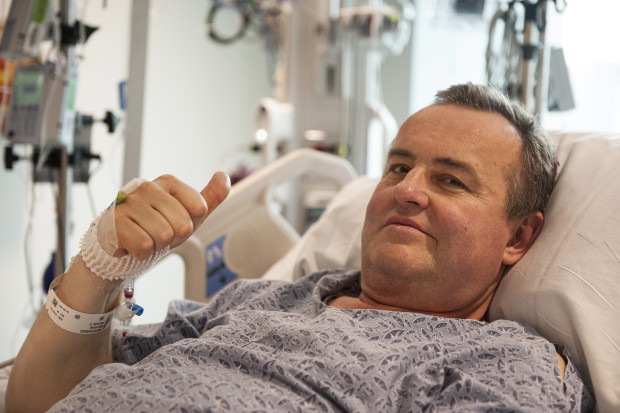
In this May 13, 2016 photo provided by Massachusetts General Hospital, Thomas Manning gives a thumbs up after being asked how he was feeling following the first penis transplant in the United States, in Boston. The organ was transplanted from a deceased donor. SAM RILEY / MASS GENERAL HOSPITAL / AP
WASHINGTON, United States — A 64-year-old man who lost most of his penis to cancer is recovering well after undergoing the United States’ first penis transplant operation, doctors said Monday.
The 15-hour surgery took place earlier this month at Massachusetts General Hospital in Boston, and is the third such operation known in the world.
READ: First penis transplant in US set | US performs its first uterus transplant
“The patient, Thomas Manning, 64, of Halifax, Massachusetts, continues to recover well, with blood flow established to the donor organ and no signs of bleeding, rejection or infection,” the hospital said in a statement.
“While the patient is still early in the post-surgical healing process, his physicians say they are cautiously optimistic he will regain function that he lost in 2012.”
The penis came from a dead donor who matched Manning’s blood type and skin tone.
Manning expressed his gratitude to the donor and his family, which has asked to remain anonymous, and said he wanted to go public with his story to eliminate the shame and stigma associated with the loss of a penis.
“In sharing this success with all of you, it’s my hope we can usher in a bright future for this type of transplantation,” Manning said in a statement.
Doctors at Massachusetts General have been working on the procedure for more than three years, including practicing on cadavers, with the goal of perfecting the method before they offer it to a wider pool of candidates, particularly soldiers who sustained genital damage or loss in war zones.
In an interview with The New York Times, Manning said doctors discovered he had a rare form of penile cancer in 2012.
After removing the tumor, he was left with a stump about an inch long (2.5 centimeters).
Manning, who was single when he was diagnosed with cancer, had to sit in order to urinate and was fearful of becoming intimate with a woman.
“I wouldn’t go near anybody,” he was quoted as saying.
“I couldn’t have a relationship with anybody. You can’t tell a woman, ‘I had a penis amputation.'”
The operation’s three main goals were to reconstruct the genitalia to a more natural appearance, to allow the patient to urinate normally and potentially to achieve sexual function.
“We are hopeful that these reconstructive techniques will allow us to alleviate the suffering and despair of those who have experienced devastating genitourinary injuries and are often so despondent they consider taking their own lives,” said doctor Curtis Cetrulo of the MGH Division of Plastic and Reconstructive Surgery and the Transplant Center.
The first penis transplant in the world took place in China in 2006, but it was later removed due to “a severe psychological problem of the recipient and his wife,” doctors said.
The world’s first successful penis transplant was announced last year in South Africa.
The donated organ was grafted onto a 21-year-old man who lost his penis in a botched circumcision.